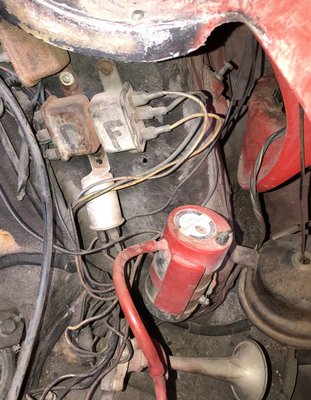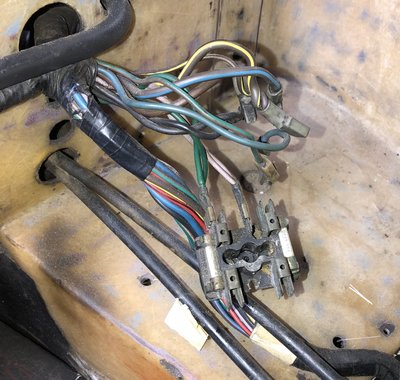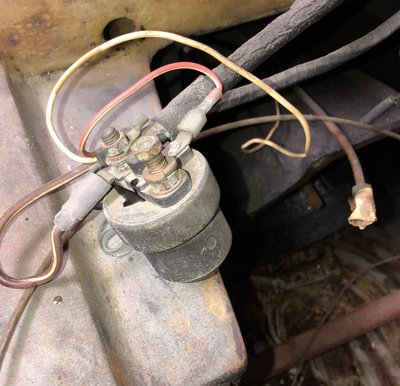Anything unusual on the S4 wiring to be aware of?
18 posts
• Page 1 of 2 • 1, 2
Hello gentlemen, hope it has been a good weekend for everyone.
I have the fiberglass repairs (to a driver level) under control so I am going to start picking at the wiring now as time allows. It looks pretty straight forward / standard for the English cars I am familiar with but wanted to ask if there are any oddball items to be aware of?
Any customary upgrades or preventative items that you all can recommend?
Thanks!
I have the fiberglass repairs (to a driver level) under control so I am going to start picking at the wiring now as time allows. It looks pretty straight forward / standard for the English cars I am familiar with but wanted to ask if there are any oddball items to be aware of?
Any customary upgrades or preventative items that you all can recommend?
Thanks!
SoCal
1969 Elan DHC
1969 Elan DHC
- tdskip
- Third Gear

- Posts: 428
- Joined: 13 Sep 2012
elanfan1 wrote:A decent earth away from the damp of the boot floor and thicker earth wires for the window motors. I think modern connectors behind the dash where they aren?t obvious is good improvement.
Good tips, thank you Steve.
SoCal
1969 Elan DHC
1969 Elan DHC
- tdskip
- Third Gear

- Posts: 428
- Joined: 13 Sep 2012
Headlight wiring is very strange, particularly for a federal car... Do you have fail safe headlight pods & micro switches on the dash switch?
Search on federal headlight wiring.... found it - http://www.lotuselan.net/forums/viewtopic.php?f=38&t=30133&start=
Search on federal headlight wiring.... found it - http://www.lotuselan.net/forums/viewtopic.php?f=38&t=30133&start=
Phil Harrison
1972 Elan Sprint 0260K
1972 Elan Sprint 0260K
-

pharriso - Coveted Fifth Gear

- Posts: 3186
- Joined: 15 Sep 2010
You're right that it's reasonably straightforward but that doesn't mean that it can't behave strangely. As previously mentioned grounds and headlamps are areas that can be confusing and hard to diagnose.
Things that come to mind immediately are:
- I would jettison the original bimetallic 10v voltage stabiliser and get a solid state one. It's very hard to trust/test the bimetallic one.
- A simple mod is to put a link between BR and BP at the cheap/rusty headlamp microswitches so that they operate in parallel - then if either one fails the headlamps keep working.
- If you want the headlamp flasher to work you may have to decide which side of the relay to place the flasher. Generally, on the control side of the relay (low current) they flash slowly while on the switched side of the relay (high current) they flash quickly.
- A minor wiring change is required if you wish to convert to electronic ignition (to accommodate the concomitant tacho conversion from RVI to RVC operation).
- Minor changes are needed if you wish to switch from a dynamo/generator to an alternator - the voltage controller on the bulkhead is no longer needed because voltage control is done by the alternator itself.
- Most modern high torque starters have their own built-in solenoid, so if you wish to use one you'll need to decide if you want to dump the original bulkhead solenoid or keep it so that you run both solenoids in series (this is actually useful because keeping the solenoid on the bulkhead allows you to turn the engine over on the battery while the ignition is off).
- Finding a turn signal flasher unit that works at all (reliably, at a consistent speed, and drives the tell-tale in speedo/tacho), let alone with LEDs, and makes an audible sound, is an interesting/fruitless exercise.
- If I were starting from scratch I might lay in wiring for an electric fuel pump in case I want to install one someday.
- There are surely other items that don't come to mind right now.....
Also, I recently found this in a response to an article in a recent Hagerty newsletter. It seems useful to me.
Nick
------------
By Dave Braun:
The British wiring codes are amazingly simple and easy to learn. Brown is power, black is ground. After it is switched in the ignition switch, Brown becomes white. When White is fused, it becomes the green wires, and when Brown is fused, it becomes the purple circuits. When Brown goes through the headlamp circuits it comes out as Red with Green stripes for parking lights, which do go through the fuse block and come out red to go to the lamps, and red with a white stripe to go to the dash lights., and brown comes out of the head lamp switch as blue for head lamp dip switch. blue with white stripes are main beam, and blue with red strips are dipped beams. Any wire that has a black stripe is a typically a switched circuit ground (like a lot of negative side two wire horn systems) and green wires tend to feed the convenience things on the car. The yellow wires are for the alternator or generator. There are more, but armed with this info you can troubleshoot almost any system on a British car.
Grounds are the big problem, keep them clean and assemble them with silicone dielectric grease. the little bullet connectors throughout the car need to be likewise cleaned and assembled with dielectric grease, and check to make sure the heat hasn?t overcome the springback of the metal for the secure connections. Some of the weaker contacts in the switching can greatly benefit from having a simple 12 volt relay placed in the circuit to take the electrical load and heat off the switches. Although early British cars typically have two fuses for the entire car, and the later ones have four (up to the early eighties) the electrical systems if properly cared for and kept in good order are almost bullet proof.
Things that come to mind immediately are:
- I would jettison the original bimetallic 10v voltage stabiliser and get a solid state one. It's very hard to trust/test the bimetallic one.
- A simple mod is to put a link between BR and BP at the cheap/rusty headlamp microswitches so that they operate in parallel - then if either one fails the headlamps keep working.
- If you want the headlamp flasher to work you may have to decide which side of the relay to place the flasher. Generally, on the control side of the relay (low current) they flash slowly while on the switched side of the relay (high current) they flash quickly.
- A minor wiring change is required if you wish to convert to electronic ignition (to accommodate the concomitant tacho conversion from RVI to RVC operation).
- Minor changes are needed if you wish to switch from a dynamo/generator to an alternator - the voltage controller on the bulkhead is no longer needed because voltage control is done by the alternator itself.
- Most modern high torque starters have their own built-in solenoid, so if you wish to use one you'll need to decide if you want to dump the original bulkhead solenoid or keep it so that you run both solenoids in series (this is actually useful because keeping the solenoid on the bulkhead allows you to turn the engine over on the battery while the ignition is off).
- Finding a turn signal flasher unit that works at all (reliably, at a consistent speed, and drives the tell-tale in speedo/tacho), let alone with LEDs, and makes an audible sound, is an interesting/fruitless exercise.
- If I were starting from scratch I might lay in wiring for an electric fuel pump in case I want to install one someday.
- There are surely other items that don't come to mind right now.....
Also, I recently found this in a response to an article in a recent Hagerty newsletter. It seems useful to me.
Nick
------------
By Dave Braun:
The British wiring codes are amazingly simple and easy to learn. Brown is power, black is ground. After it is switched in the ignition switch, Brown becomes white. When White is fused, it becomes the green wires, and when Brown is fused, it becomes the purple circuits. When Brown goes through the headlamp circuits it comes out as Red with Green stripes for parking lights, which do go through the fuse block and come out red to go to the lamps, and red with a white stripe to go to the dash lights., and brown comes out of the head lamp switch as blue for head lamp dip switch. blue with white stripes are main beam, and blue with red strips are dipped beams. Any wire that has a black stripe is a typically a switched circuit ground (like a lot of negative side two wire horn systems) and green wires tend to feed the convenience things on the car. The yellow wires are for the alternator or generator. There are more, but armed with this info you can troubleshoot almost any system on a British car.
Grounds are the big problem, keep them clean and assemble them with silicone dielectric grease. the little bullet connectors throughout the car need to be likewise cleaned and assembled with dielectric grease, and check to make sure the heat hasn?t overcome the springback of the metal for the secure connections. Some of the weaker contacts in the switching can greatly benefit from having a simple 12 volt relay placed in the circuit to take the electrical load and heat off the switches. Although early British cars typically have two fuses for the entire car, and the later ones have four (up to the early eighties) the electrical systems if properly cared for and kept in good order are almost bullet proof.
-

elanner - Fourth Gear

- Posts: 546
- Joined: 14 Sep 2010
Very helpful post, thank you Nick.
I'll get searching, but is the alternator swap pretty straight forward? Ditto on high torque starters? If I need to touch either of those anyway in my prior MG and TR builds I've just straight away upgraded historically.
I'll get searching, but is the alternator swap pretty straight forward? Ditto on high torque starters? If I need to touch either of those anyway in my prior MG and TR builds I've just straight away upgraded historically.
SoCal
1969 Elan DHC
1969 Elan DHC
- tdskip
- Third Gear

- Posts: 428
- Joined: 13 Sep 2012
pharriso wrote:Headlight wiring is very strange, particularly for a federal car... Do you have fail safe headlight pods & micro switches on the dash switch?
Search on federal headlight wiring.... found it - http://www.lotuselan.net/forums/viewtopic.php?f=38&t=30133&start=
Oops - sorry Phil, missed this.
Will check that out tomorrow and report back. The car is pretty original but not sure what I have. Thanks for the consideration.
SoCal
1969 Elan DHC
1969 Elan DHC
- tdskip
- Third Gear

- Posts: 428
- Joined: 13 Sep 2012
tdskip wrote:I'll get searching, but is the alternator swap pretty straight forward? Ditto on high torque starters? If I need to touch either of those anyway in my prior MG and TR builds I've just straight away upgraded historically.
The previous owner fitted my alternator but it seems straightforward enough once you figure out the exciter circuit (powered via the dashboard ignition lamp). You can either remove the bulkhead controller or, to keep things looking original, simply adjust the connectors so that it doesn't actually do anything. Somebody in the forum will have done this so be able to give you accurate details. Physically fitting the alternator to the engine can be the most challenging part of the swap, there are lots of posts about it.
For a high torque starter if you keep the bulkhead solenoid you simply power the starter's solenoid off the main battery power lead with a short jumper down at the starter. If you remove the bulkhead solenoid you'll need to run a separate wire from the ignition switch down to the starter's solenoid. It's been a while since I did it but I think that's right.
Nick
-

elanner - Fourth Gear

- Posts: 546
- Joined: 14 Sep 2010
I recently rewired my Federal Sprint.
A few upgrades:
Replacing the 2-fuse fuseblock with a modern 6-fuse block, using blade fuses, and locating it away from the exhaust manifold heat. This let me use separate fuses for 1) Green circuit, 2) Headlights, 3) Rad fan, 4) parking/marker lights, 5) Purple circuit, and 6) accessory circuit. Only brown and white are now unfused.
Already mentioned, but larger wires (14 gauge) for the window motors, both + and -. Along with fresh connections, they now raise/lower at a rate comparable to modern cars.
Using modern connectors anywhere they were needed to enable removing the dash. Bullet connectors really aren't designed for disconnecting. In my case I used mate-n-lok connectors, but I'm sure there are lots of alternatives. I've since had my dash out again, it makes the dissassembly/reassembly much easier.
I added footwell lights (lcds) while I was at it. I smile every time I open the door at night, now.
Have fun.
A few upgrades:
Replacing the 2-fuse fuseblock with a modern 6-fuse block, using blade fuses, and locating it away from the exhaust manifold heat. This let me use separate fuses for 1) Green circuit, 2) Headlights, 3) Rad fan, 4) parking/marker lights, 5) Purple circuit, and 6) accessory circuit. Only brown and white are now unfused.
Already mentioned, but larger wires (14 gauge) for the window motors, both + and -. Along with fresh connections, they now raise/lower at a rate comparable to modern cars.
Using modern connectors anywhere they were needed to enable removing the dash. Bullet connectors really aren't designed for disconnecting. In my case I used mate-n-lok connectors, but I'm sure there are lots of alternatives. I've since had my dash out again, it makes the dissassembly/reassembly much easier.
I added footwell lights (lcds) while I was at it. I smile every time I open the door at night, now.
Have fun.
Steve Lyle
1972 Elan Sprint 0248k @ https://www.mgexp.com/registry/1972-Lot ... 48K.30245/
1972 MGB Roadster @ https://www.mgexp.com/registry/1972-MG- ... 842G.4498/
2007 BMW 335i Coupe
1972 Elan Sprint 0248k @ https://www.mgexp.com/registry/1972-Lot ... 48K.30245/
1972 MGB Roadster @ https://www.mgexp.com/registry/1972-MG- ... 842G.4498/
2007 BMW 335i Coupe
-

steve lyle - Fourth Gear

- Posts: 510
- Joined: 15 Jun 2015
I?ve been contemplating wiring mods to my +2 S130 during its rebuild. I plan to introduce 5 integrally fused relays for the following: cooling fan, horn, headlights (main & dipped) and fuel pump. These will be daisy chained by one power feed cable and similarly daisy chained single earth wire. The relays will be switched by the existing wiring for those units, except pump and fan which are new.
This will reduce loading on the ignition switch and fuses and add 5 new fuses. It should be relatively easy to do, I think.
This will reduce loading on the ignition switch and fuses and add 5 new fuses. It should be relatively easy to do, I think.
Elan +2
Elise mk 1
Elise mk 1
- Donels
- Fourth Gear

- Posts: 710
- Joined: 10 Sep 2016
18 posts
• Page 1 of 2 • 1, 2
Total Online:
Users browsing this forum: No registered users and 24 guests




